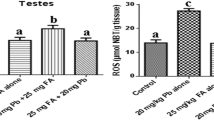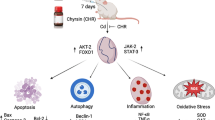Abstract
Cadmium chloride (CdCl2)-induced biochemical changes were characterized in male, CD-1 mouse testes. CdCl2 inhibited the testes microsomal Na–, K–-ATPase activity in vitro and in vivo. The inhibitory range was 30–50 μm and the concentration for half maximal inhibition (IC50 value) was 90 μm over 5 min preincubation. CdCl2 (2mg/kg/day, s.c.) for 2 days significantly inhibited testes Na–, K–-ATPase (near 90% inhibition). The content of testicular GSH and the ratio of reduced glutathione (GSH)/GSSG (oxidized glutathione) decreased in CdCl2-treated groups. Using salicylate as a trapping agent and high pressure liquid chromatography with electrochemical detection (LCED), we measured the OH production in vivo. 2,5-dihydroxybenzoic acid (2,5-DHBA) and 2,3-dihydroxybenzoic acid (2,3-DHBA) as indices of hydroxyl free radical formation significantly increased after 5 days CdCl2 exposure. Pretreatment with vitamin E (20 mg/kg, s.i.d., i.m., 7d) protected CdCl2-induced increase in OH generation in testes. From this study, it was demonstrated that CdCl2 induced testicular toxicity could possibly be mediated by a significant increase in hydroxyl free radical formation and a reduction in GSH content and Na–, K–-ATPase activity. Vitamin E seems to prevent the CdCl2 induced increase in hydroxyl free radical generation.
Similar content being viewed by others
References
Akera T, Brody TM (1969) The effects of ouabain on sodium- and potassium-activated adenosine triphosphatase from the hearts of several mammalian species. J Pharmacol Exp Ther 170:17–26
Ali MM, Shukla GS, Srivastava RS, Mathur N, Chandra SV (1993) Effects of vitamin E on cadmium-induced locomotor dysfunctions in rats. Vet Hum Toxicol 35:109–111
Ames BN (1983) Dietary carcinogens and anticarcinogens, oxygen radicals and degenerative diseases. Science 221:1256–1264
Aoki A, Hoffer AP (1978) Reexamination of the lesions in rat testis caused by cadmium. Biol Reprod 18:579–591
Borel JP (1983) Radicals libries oxygenes, tissue conjontifet inflammation. Pathol Biol 31:8–10
Broekhuysen J, Clinet M, Delisee C (1972) Action of amiodarone on guinea pig heart sodium and potassium activated adenosine triphosphatase, comparison with ouabain. Biochem Pharmacol 21:2951–2960
Bus JS, Cagon SZ, Olgaard M, Gibson JE (1976) A mechanism of paraquat toxicity in mice and rats. Toxicol Appl Pharmacol 35:501–513
Chen CL, Sangiah S, Patterson E, Berlin KD (1992) Effects of BRB-1–28, a novel antiarrhythmic agent, and its derivatives on cardiac Na–, K–-ATPase, Mg2+-ATPase activities and contractile force. Res Comm Chem Pathol Pharmacol 78:3–16
Ewing D (1983) Synergistic damage from H2O2 and OH radicals in irradiated cells. Radiation Res 94:171–189
Floyd RA, Watson JJ, Wong PK (1984) Sensitive assay of hydroxyl free radical formation utilizing high pressure liquid chromatography with electrochemical detection of phenol and salicylate hydroxylation products. J Biochem Biophys Methods 10:221–235
Floyd RA, Henderson R, Watson JJ, Wong PK (1986) Use of salicylate with high pressure liquid chromatography and electrochemical detection (LCED) as a sensitive measure of hydroxyl free radicals. J Free Radic Biol Med 2:13–18
Gabor S, Anca Z, Bordas E (1978) Cadmium-induced lipid peroxidation in kidney and testes. Rev Roum Biochem 15:113–117
Gunn SA, Gould TC, Anderson WAD (1966) Selectivity of organ response to cadmium injury and various protective measures. Proc Soc Exp Med 122:1036–1039
Gunn SA, Gould TC, Anderson WAD (1968) Mechanism of zinc, cysteine and selenium protection against cadmium-induced vascular injury to mouse testis. J Reprod Fert 15:65–70
Gunn SA, Gould TC (1975) Vasculature of the testis and adnexa. In: Hamilton DW, Greep RO (eds) The testis, Waverly Press Inc, Baltimore, MD pp 117–142
Harman D (1981) The aging process. Proc Natl Acad Sci 78:7124–7128
Heinrich U (1988) Carcinogenicity of cadmium. In: Stoeppler M, Piscator M (eds) Environmental toxin series 2: Cadmium. Springer-Verlag, FRG, pp 14–24
Kinne-Saffran E, Hulseweh M, Pfaff CH, Kinne RKH (1993) Inhibition of Na, K-ATPase by cadmium: Different mechanisms in different species. Toxicol Appl Pharmcol 121:22–29
Koizumi T, Li ZG, Tatsumoto H (1992) DNA damaging activity of cadmium in leydig cells, a target cell population for cadmium carcinogenesis in rat testis. Toxicol Lett 63:211–220
Larsson A, Orrenius S, Holmgren A (1983) Function of glutathione: Biochemical, physiological, and toxicological. Fifth Karolinska Institute Nobel Conference, New York
Liebler DC (1993) The role of metabolism in the antioxidant function of vitamin E. Critical Rev Toxicol 23:147–169
Meister A, Anderson ME (1983) Glutathione. Annu Rev Biochem 52:711–760
Min KS, Terano Y, Onosaka S, Tanaka K (1992) Induction of metal-lothionein synthesis by menadione or CCl4 is independent of free radical production. Toxicol Appl Pharmacol 113:74–79
Nohl H, Jordan W (1983) OH-generation by adriamycin semiquinone and H2O2. An explanation of the cardiotoxicity of anthracycline antibiotics. Biochem Biophys Res Commun 114:197–205
Pleasants EW, Waslien C, Naughton BA (1993) Dietary modulation of the symptoms of cadmium toxicity in rats: Effects of vitamins A, C, D, D hormone, and fluoride. Nutri Res 13:839–850
Preston AM (1991) Cigarette smoking—Nutritional implications. Prog Food Nutr Sci 15:183–271
Ragan HA, Mast TJ (1990) Cadmium In: Ware EW (ed) Reviews of environmental contamination and toxicology. Springer-Verlag, NY, pp 1–22
Rajanwa B, Chapatwala KD, Vaishnav DD, Dasaiah D (1981) Changes in ATPase activities in tissues of rats fed on cadmium. J Environ 2:1–9
Samarawickrama GP (1979) The chemistry, biochemistry and biology of cadmium. Webb M, Elsevier/North-Holland Biomedical press, NY, pp 341–421
Shen Y, Sangiah S (1994) Influence of cadmium on ketamine-induced anesthesia and brain microsomal Na–, K–-ATPase in mice. Bull Environ Contamin Toxicol 53:591–597
Shukla GS, Hussain T, Chandra SV (1987) Possible role of regional superoxide dismutase activity and lipid peroxide levels in cadmium neurotoxicity: In vivo and in vitro studies in growing rats. Life Sci 41:2215–2221
Singhal RK, Anderson ME, Meister A (1987) Glutathione, a first line of defense against cadmium toxicity. FASEB J 1:220–223
Slaga TJ (1983) Overview of tumor promotion in animals. Environ Health Perspect 50:3–14
Smith PK, Krohn RI, Hermanson GT, Mallia AK (1985) Measurement of protein using bicinchoninic acid. Anal Biochem 150:76–85
Tallarida RJ, Murray RB (1986) Manual of Pharmacologic Calculations with Computer Programs. Tallarida RJ (ed), Springer-Verlag, NY pp 131–134
Teare JP, Punchard NA, Powell JJ (1993) Automated spectrophotometric method for determining oxidized and reduced glutathione in liver. Clin Chem 39:686–689
Waalkes MP, Oberdoster G (1990) Cadmium carcinogenesis. In: Foulkes ED (ed) Biological effects of heavy metals. CRC Press, Boca Raton, FL, pp 129–158
Wahba ZZ, Hernandez L, Issaq HJ, Waalkes MP (1990) Involvement of sulfhydryl metabolism in tolerance to cadmium in testicular cells. Toxicol Appl Pharmacol 104:157–166
Yusa T, Crapo JD, Freeman BA (1984) Hyperoxia enhances lung and liver nuclear superoxide generation. Biochim Biophys Acta 798:167–174
Author information
Authors and Affiliations
Rights and permissions
About this article
Cite this article
Shen, Y., Sangiah, S. Na+, K+-ATPase, glutathione, and hydroxyl free radicals in cadmium chloride-induced testicular toxicity in mice. Arch. Environ. Contam. Toxicol. 29, 174–179 (1995). https://doi.org/10.1007/BF00212967
Received:
Revised:
Issue Date:
DOI: https://doi.org/10.1007/BF00212967




